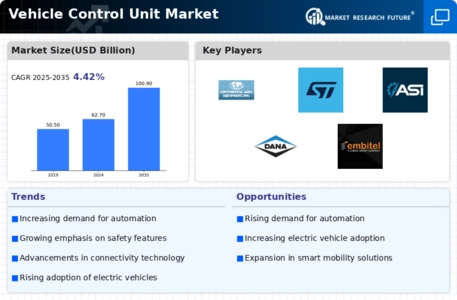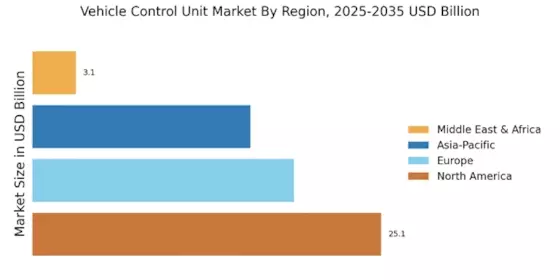Rising Demand for Electric Vehicles
The increasing consumer preference for electric vehicles (EVs) is a pivotal driver in the Vehicle Control Unit Market. As more manufacturers pivot towards electrification, the demand for sophisticated vehicle control units that manage battery systems, energy distribution, and regenerative braking is surging. In 2025, it is estimated that the EV market will account for approximately 30% of total vehicle sales, necessitating advanced control units to optimize performance and efficiency. This shift not only enhances vehicle functionality but also aligns with broader environmental goals, thereby propelling the Vehicle Control Unit Market forward. The integration of these units is crucial for ensuring that EVs meet performance expectations while adhering to stringent regulatory standards.
Integration of Connectivity Features
The growing trend towards vehicle connectivity is reshaping the Vehicle Control Unit Market. With the advent of the Internet of Things (IoT), vehicles are increasingly equipped with features that allow for real-time data exchange between the vehicle and external systems. This connectivity enhances functionalities such as remote diagnostics, over-the-air updates, and vehicle-to-everything (V2X) communication. As of 2025, it is anticipated that connected vehicles will represent a substantial portion of the automotive market, driving demand for advanced control units that can manage these complex interactions. The integration of connectivity features not only improves user experience but also contributes to enhanced safety and efficiency, thereby propelling the Vehicle Control Unit Market.
Regulatory Pressures for Safety and Emissions
Regulatory pressures aimed at improving vehicle safety and reducing emissions are significant drivers in the Vehicle Control Unit Market. Governments worldwide are implementing stringent regulations that require advanced safety features and lower emissions from vehicles. This has led manufacturers to invest in sophisticated control units that can monitor and manage various vehicle systems to comply with these regulations. By 2025, it is expected that compliance with these regulations will necessitate the incorporation of advanced vehicle control units in a majority of new vehicle models. This trend not only ensures adherence to legal standards but also enhances the overall safety and environmental performance of vehicles, thereby stimulating growth in the Vehicle Control Unit Market.
Advancements in Autonomous Driving Technologies
The rapid evolution of autonomous driving technologies is significantly influencing the Vehicle Control Unit Market. As automakers invest heavily in research and development, the need for advanced control units that can process vast amounts of data in real-time becomes paramount. These units are essential for the functioning of various autonomous features, including lane-keeping assistance and adaptive cruise control. By 2025, it is projected that the market for autonomous vehicles will reach a valuation of over 100 billion dollars, underscoring the critical role of vehicle control units in this sector. The ability to seamlessly integrate these technologies into existing vehicle architectures is likely to drive further innovation within the Vehicle Control Unit Market.
Consumer Demand for Enhanced Vehicle Performance
The increasing consumer demand for enhanced vehicle performance is a driving force in the Vehicle Control Unit Market. As consumers seek vehicles that offer superior handling, acceleration, and fuel efficiency, manufacturers are compelled to develop advanced control units that optimize engine performance and transmission systems. In 2025, it is projected that the performance vehicle segment will witness substantial growth, further emphasizing the need for innovative control solutions. These units play a crucial role in fine-tuning vehicle dynamics and ensuring that performance metrics meet consumer expectations. Consequently, the focus on performance enhancement is likely to propel advancements in the Vehicle Control Unit Market, fostering a competitive landscape among manufacturers.


















Leave a Comment